Significant Wave Height Prediction in the South China Sea Based on the ConvLSTM Algorithm
Abstract
1. Introduction
2. Data and Methods
2.1. Data and Pre-Processing
2.1.1. Data
2.1.2. Preprocessing
2.2. ConvLSTM Algorithm
2.3. Constructing the SWH Prediction Model
2.4. Model Quality Assessment Methods
3. Results and Discussion
3.1. Validation of SWH from WWIII
3.2. Model A Sensitivity Experiments
3.3. Model Comparison and Analysis
3.4. Spatial Distribution and Statistical Analysis of Model Errors
3.5. Model Performance in Extreme Weather
4. Conclusions
Author Contributions
Funding
Institutional Review Board Statement
Informed Consent Statement
Data Availability Statement
Acknowledgments
Conflicts of Interest
References
- Wu, L.; Li, X.; Wu, T. South China Sea wave height trends analysis using 20CR reanalysis. In Proceedings of the 2016 International Conference on Automatic Control and Information Engineering, Hong Kong, China, 22–23 October 2016; pp. 57–61. [Google Scholar]
- Sun, Z.; Zhang, H.; Xu, D.; Liu, X.; Ding, J. Assessment of wave power in the South China Sea based on 26-year high-resolution hindcast data. Energy 2020, 197, 117218. [Google Scholar] [CrossRef]
- Zhang, Y.; Zhou, W.; Leung, M.Y.T. Phase relationship between summer and winter monsoons over the South China Sea: Indian Ocean and ENSO forcing. Clim. Dyn. 2018, 52, 5229–5248. [Google Scholar] [CrossRef]
- Chen, X.; Wang, Y.; Zhao, K.; Wu, D. A Numerical Study on Rapid Intensification of Typhoon Vicente (2012) in the South China Sea. Part I: Verification of Simulation, Storm-Scale Evolution, and Environmental Contribution. Mon. Weather Rev. 2017, 145, 877–898. [Google Scholar] [CrossRef]
- Wang, J.; Liu, J.; Wang, Y.; Liao, Z.; Sun, P. Spatiotemporal variations and extreme value analysis of significant wave height in the South China Sea based on 71-year long ERA5 wave reanalysis. Appl. Ocean Res. 2021, 113, 102750. [Google Scholar] [CrossRef]
- Wu, Z.; Chen, J.; Jiang, C.; Deng, B. Simulation of extreme waves using coupled atmosphere-wave modeling system over the South China Sea. Ocean Eng. 2021, 221, 108531. [Google Scholar] [CrossRef]
- Sverdrup, H.U.; Munk, W.H. Wind, Sea and Swell: Theory of Relations for Forecasting; Hydrographic Office: Taunton, UK, 1947. [Google Scholar]
- Neumann, G.; Pierson, W.J. A detailed comparison of theoretical wave spectra and wave forecasting methods. Dtsch. Hydrogr. Z. 1957, 10, 134–146. [Google Scholar] [CrossRef]
- Kamranzad, B.; Etemad-Shahidi, A.; Kazeminezhad, M.H. Wave height forecasting in Dayyer, the Persian Gulf. Ocean Eng. 2011, 38, 248–255. [Google Scholar] [CrossRef]
- Wamdi, G. The WAM model—A third generation ocean wave prediction model. J. Phys. Oceanogr. 1988, 18, 1775–1810. [Google Scholar] [CrossRef]
- Booij, N.; Ris, R.C.; Holthuijsen, L.H. A third-generation wave model for coastal regions: 1. Model description and validation. J. Geophys. Res. Oceans 1999, 104, 7649–7666. [Google Scholar] [CrossRef]
- Rogers, W.E.; Hwang, P.A.; Wang, D.W. Investigation of wave growth and decay in the SWAN model: Three Regional-Scale applications. J. Phys. Oceanogr. 2003, 33, 366–389. [Google Scholar] [CrossRef]
- Tolman, H.L. User Manual and System Documentation of WAVEWATCH III Version 3.14. 2009. Available online: https://polar.ncep.noaa.gov/mmab/papers/tn276/MMAB_276.pdf (accessed on 8 December 2021).
- Mentaschi, L.; Besio, G.; Cassola, F.; Mazzino, A. Performance evaluation of WAVEWATCH III in the Mediterranean Sea. Ocean Model. 2015, 90, 82–94. [Google Scholar] [CrossRef]
- Etemad-Shahidi, A.; Mahjoobi, J. Comparison between M5′ model tree and neural networks for prediction of significant wave height in Lake Superior. Ocean Eng. 2009, 36, 1175–1181. [Google Scholar] [CrossRef]
- Wang, W.; Tang, R.; Li, C.; Liu, P.; Luo, L. A BP neural network model optimized by mind evolutionary algorithm for predicting the ocean wave heights. Ocean Eng. 2018, 162, 98–107. [Google Scholar] [CrossRef]
- Deshmukh, A.N.; Deo, M.C.; Bhaskaran, P.K.; Balakrishnan Nair, T.M.; Sandhya, K.G. Neural-Network-Based data assimilation to improve numerical ocean wave forecast. IEEE J. Ocean. Eng. 2016, 41, 944–953. [Google Scholar] [CrossRef]
- Mafi, S.; Amirinia, G. Forecasting hurricane wave height in Gulf of Mexico using soft computing methods. Ocean Eng. 2017, 146, 352–362. [Google Scholar] [CrossRef]
- Fan, S.; Xiao, N.; Dong, S. A novel model to predict significant wave height based on long short-term memory network. Ocean Eng. 2020, 205, 107298. [Google Scholar] [CrossRef]
- Gao, S.; Huang, J.; Li, Y.; Liu, G.; Bi, F.; Bai, Z. A forecasting model for wave heights based on a long short-term memory neural network. Acta Oceanol. Sin. 2021, 40, 62–69. [Google Scholar] [CrossRef]
- Huang, G.; Huang, G.B.; Song, S.; You, K. Trends in extreme learning machines: A review. Neural Netw. 2015, 61, 32–48. [Google Scholar] [CrossRef]
- Cornejo-Bueno, L.; Nieto-Borge, J.C.; García-Díaz, P.; Rodríguez, G.; Salcedo-Sanz, S. Significant wave height and energy flux prediction for marine energy applications: A grouping genetic algorithm—Extreme learning machine approach. Renew. Energy 2016, 97, 380–389. [Google Scholar] [CrossRef]
- Kumar, N.K.; Savitha, R.; Al-Mamun, A. Ocean wave height prediction using ensemble of extreme learning machine. Neurocomputing 2018, 277, 12–20. [Google Scholar] [CrossRef]
- Kaloop, M.R.; Kumar, D.; Zarzoura, F.; Roy, B.; Hu, J.W. A wavelet—Particle swarm optimization—Extreme learning machine hybrid modeling for significant wave height prediction. Ocean Eng. 2020, 213, 107777. [Google Scholar] [CrossRef]
- Mahjoobi, J.; Adeli, E. Prediction of significant wave height using regressive support vector machines. Ocean Eng. 2009, 36, 339–347. [Google Scholar] [CrossRef]
- Elbisy, M.S. Sea wave parameters prediction by support vector machine using a genetic algorithm. J. Coast. Res. 2015, 314, 892–899. [Google Scholar] [CrossRef]
- Mahjoobi, J.; Etemad-Shahidi, A.; Kazeminezhad, M.H. Hindcasting of wave parameters using different soft computing methods. Appl. Ocean Res. 2008, 30, 28–36. [Google Scholar] [CrossRef]
- Scotto, M.G.; Guedes Soares, C. Bayesian inference for long-term prediction of significant wave height. Coast. Eng. 2007, 54, 393–400. [Google Scholar] [CrossRef]
- Malekmohamadi, I.; Bazargan-Lari, M.R.; Kerachian, R.; Nikoo, M.R.; Fallahnia, M. Evaluating the efficacy of SVMs, BNs, ANNs and ANFIS in wave height prediction. Ocean Eng. 2011, 38, 487–497. [Google Scholar] [CrossRef]
- Abed-Elmdoust, A.; Kerachian, R. Wave height prediction using the rough set theory. Ocean Eng. 2012, 54, 244–250. [Google Scholar] [CrossRef]
- Sepp, H.; Jürgen, S. Long short-term memory. Neural Comput. 1997, 9, 1735–1780. [Google Scholar] [CrossRef]
- Ni, C.; Ma, X. An integrated long-short term memory algorithm for predicting polar westerlies wave height. Ocean Eng. 2020, 215, 107715. [Google Scholar] [CrossRef]
- Pirhooshyaran, M.; Snyder, L.V. Forecasting, hindcasting and feature selection of ocean waves via recurrent and sequence-to-sequence networks. Ocean Eng. 2020, 207, 107424. [Google Scholar] [CrossRef]
- Shi, X.; Chen, Z.; Wang, H.; Yeung, D.Y.; Wong, W.K.; Woo, W.C. Convolutional LSTM network: A machine learning approach for precipitation nowcasting. In Proceedings of the 28th International Conference on Neural Information Processing Systems, Montreal, QC, Canada, 7–12 December 2015; pp. 802–810. [Google Scholar]
- Choi, H.; Park, M.; Son, G.; Jeong, J.; Park, J.; Mo, K.; Kang, P. Real-time significant wave height estimation from raw ocean images based on 2D and 3D deep neural networks. Ocean Eng. 2020, 201, 107129. [Google Scholar] [CrossRef]
- Zhou, S.; Xie, W.; Lu, Y.; Wang, Y.; Zhou, Y.; Hui, N.; Dong, C. ConvLSTM-Based wave forecasts in the South and East China Seas. Front. Mar. Sci. 2021, 8, 740. [Google Scholar] [CrossRef]
- Nitsure, S.P.; Londhe, S.N.; Khare, K.C. Wave forecasts using wind information and genetic programming. Ocean Eng. 2012, 54, 61–69. [Google Scholar] [CrossRef]
- Hsiao, S.-C.; Chen, H.; Wu, H.-L.; Chen, W.-B.; Chang, C.-H.; Guo, W.-D.; Chen, Y.-M.; Lin, L.-Y. Numerical Simulation of Large Wave Heights from Super Typhoon Nepartak (2016) in the Eastern Waters of Taiwan. J. Mar. Sci. Eng. 2020, 8, 217. [Google Scholar] [CrossRef]
- Chen, W.-B.; Chen, H.; Hsiao, S.-C.; Chang, C.-H.; Lin, L.-Y. Wind forcing effect on hindcasting of typhoon-driven extreme waves. Ocean Eng. 2019, 188, 106260. [Google Scholar] [CrossRef]
- Hsiao, S.-C.; Chen, H.; Chen, W.-B.; Chang, C.-H.; Lin, L.-Y. Quantifying the contribution of nonlinear interactions to storm tide simulations during a super typhoon event. Ocean Eng. 2019, 194, 106661. [Google Scholar] [CrossRef]
- Hu, H.; van der Westhuysen, A.J.; Chu, P.; Fujisaki-Manome, A. Predicting Lake Erie wave heights and periods using XGBoost and LSTM. Ocean Model. 2021, 164, 101832. [Google Scholar] [CrossRef]
- Thematic Realtime Environmental Distributed Data Services (THREDDS) Data Server (TDS). WaveWatch III Global Wave Model/Best Time Series. Available online: https://pae-paha.pacioos.hawaii.edu/thredds/ (accessed on 10 November 2021).
- Hersbach, H.; Bell, B.; Berrisford, P.; Biavati, G.; Horányi, A.; Muñoz Sabater, J.; Nicolas, J.; Peubey, C.; Radu, R.; Rozum, I.; et al. ERA5 Hourly Data on Single Levels from 1959 to Present. Available online: https://doi.org/10.24381/cds.adbb2d47 (accessed on 10 November 2021).
- China Central Weather Bureau Typhoon Network. Available online: http://typhoon.nmc.cn/web.html (accessed on 8 December 2021).
- Aviso + Cnes Data Center. Available online: https://aviso-data-center.cnes.fr/ (accessed on 12 December 2021).
- Li, X.; Xu, Y.; Liu, B.; Lin, W.; He, Y.; Liu, J. Validation and Calibration of Nadir SWH Products from CFOSAT and HY-2B with Satellites and in Situ Observations. J. Geophys. Res. Oceans 2021, 126, e2020JC016689M. [Google Scholar] [CrossRef]
- Zamani, A.; Solomatine, D.; Azimian, A.; Heemink, A. Learning from data for wind—Wave forecasting. Ocean Eng. 2008, 35, 953–962. [Google Scholar] [CrossRef]
- Wu, J. Wind-Stress coefficients: Over sea surface from breeze to hurricane. J. Geophys. Res. 1982, 87, 9704–9706. [Google Scholar] [CrossRef]
- Ji, Q.; Zhu, X.; Wang, H.; Liu, G.; Gao, S.; Ji, X.; Xu, Q. Assimilating operational SST and sea ice analysis data into an operational circulation model for the coastal seas of China. Acta Oceanol. Sin. 2015, 34, 54–64. [Google Scholar] [CrossRef]
- Powell, M.D.; Vickery, P.J.; Reinhold, T.A. Reduced drag coefficient for high wind speeds in tropical cyclones. Nature 2003, 422, 279–283. [Google Scholar] [CrossRef] [PubMed]
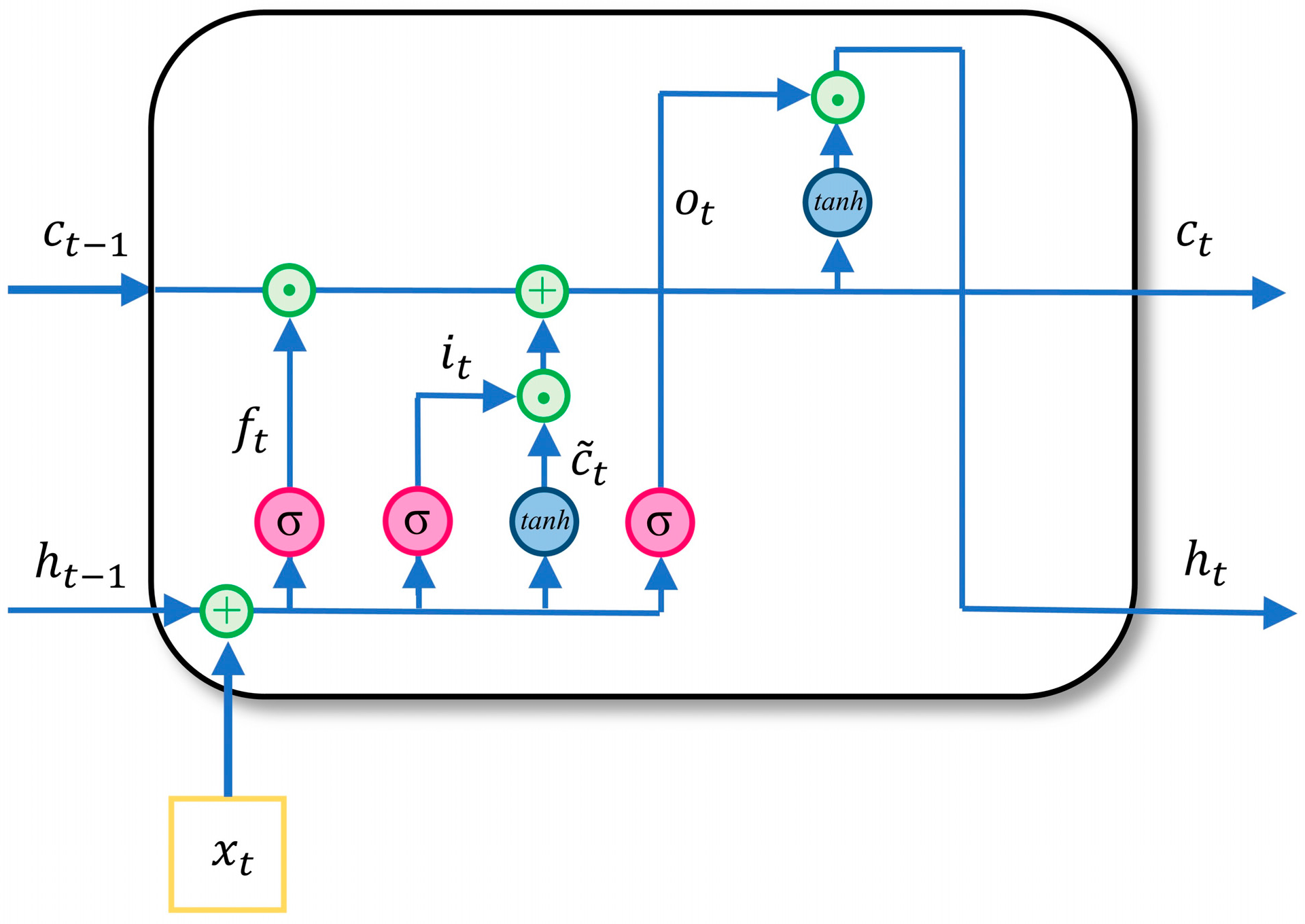
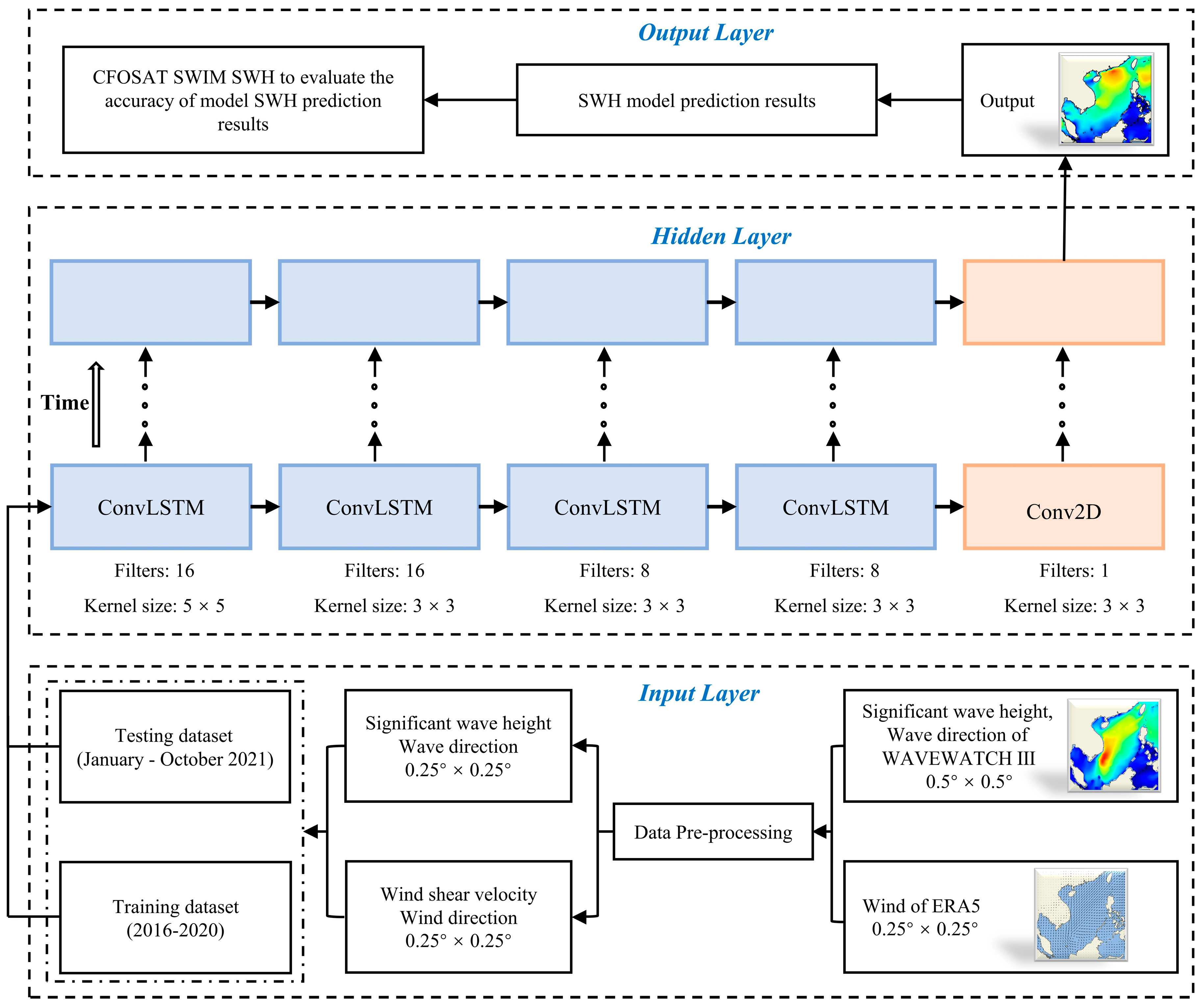

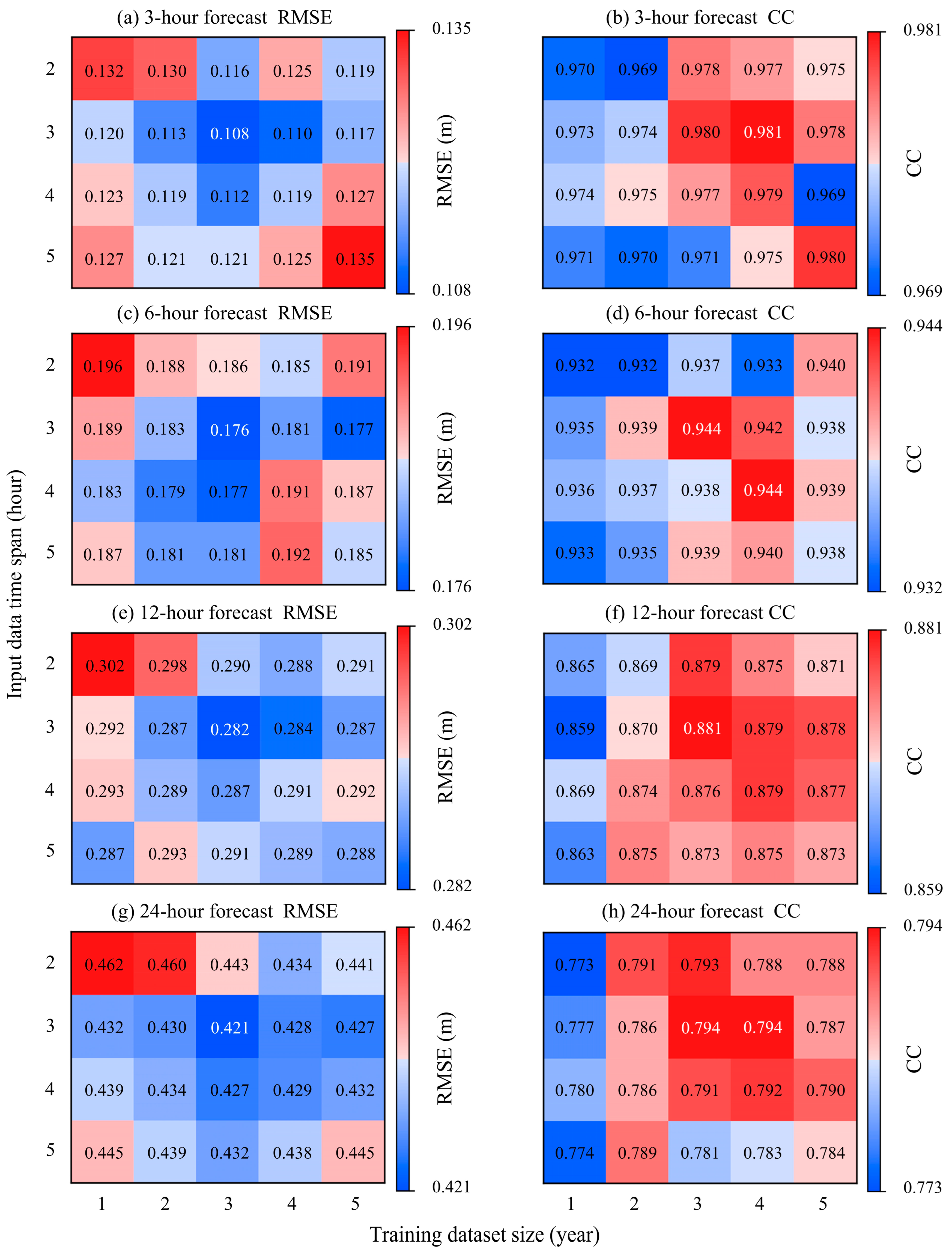
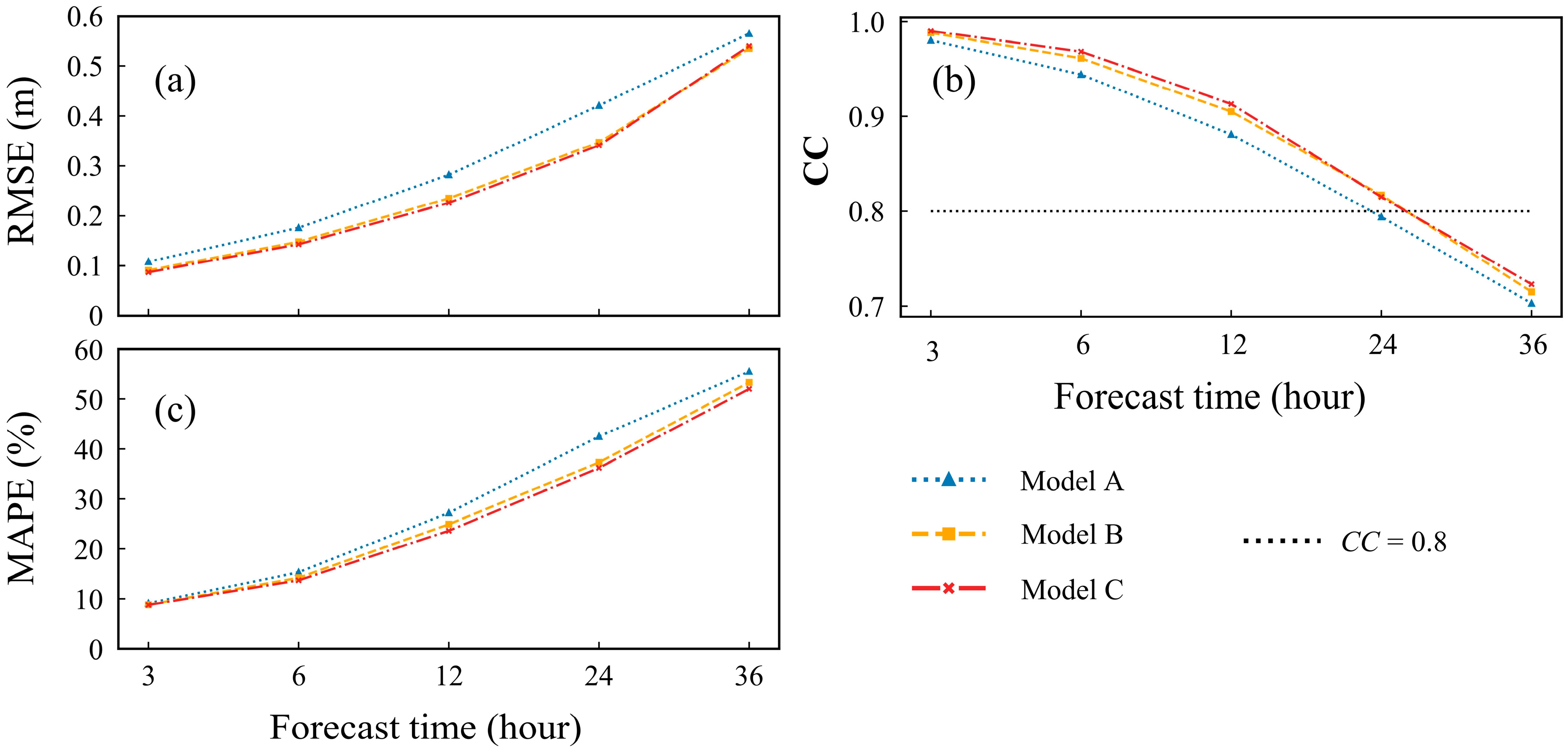
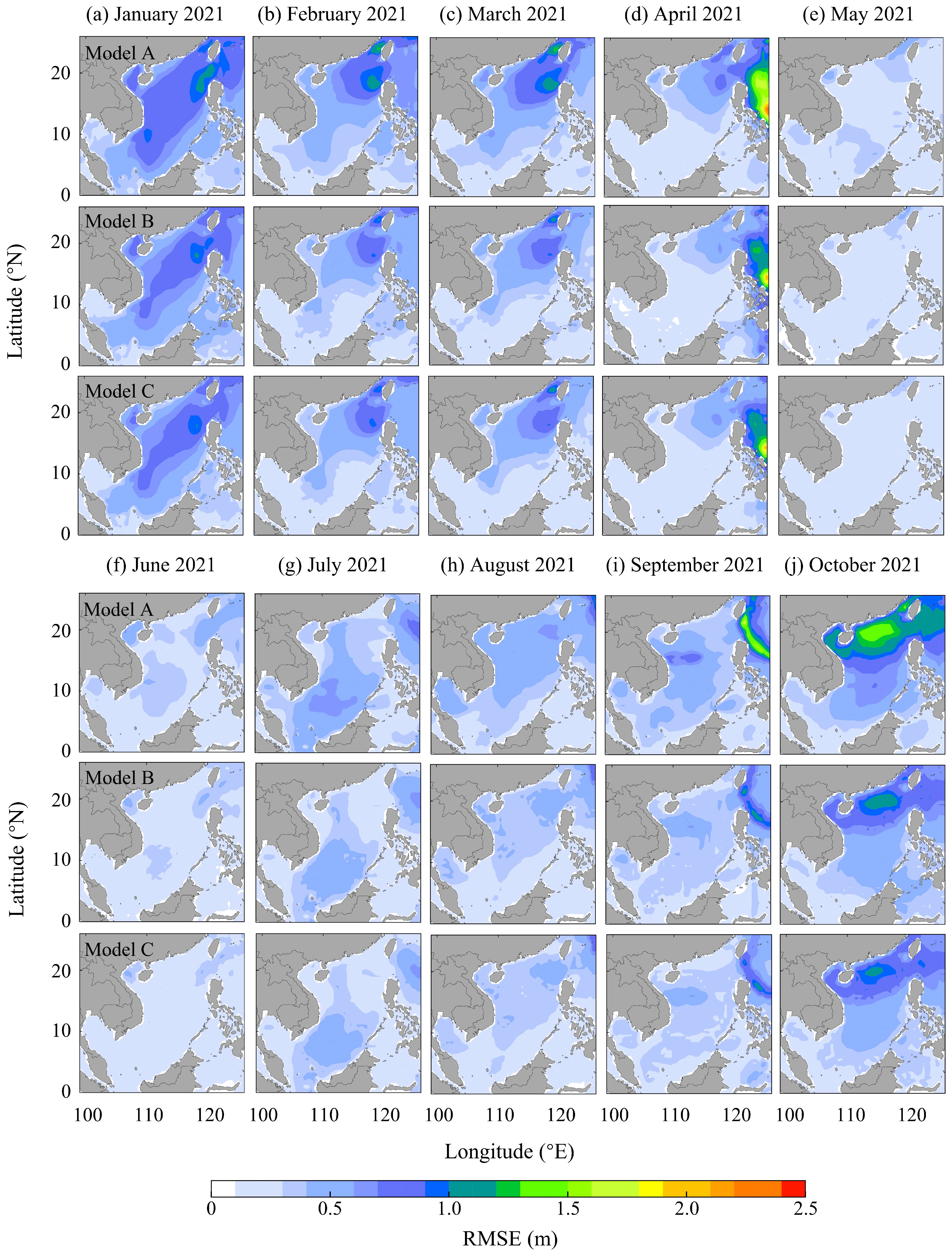
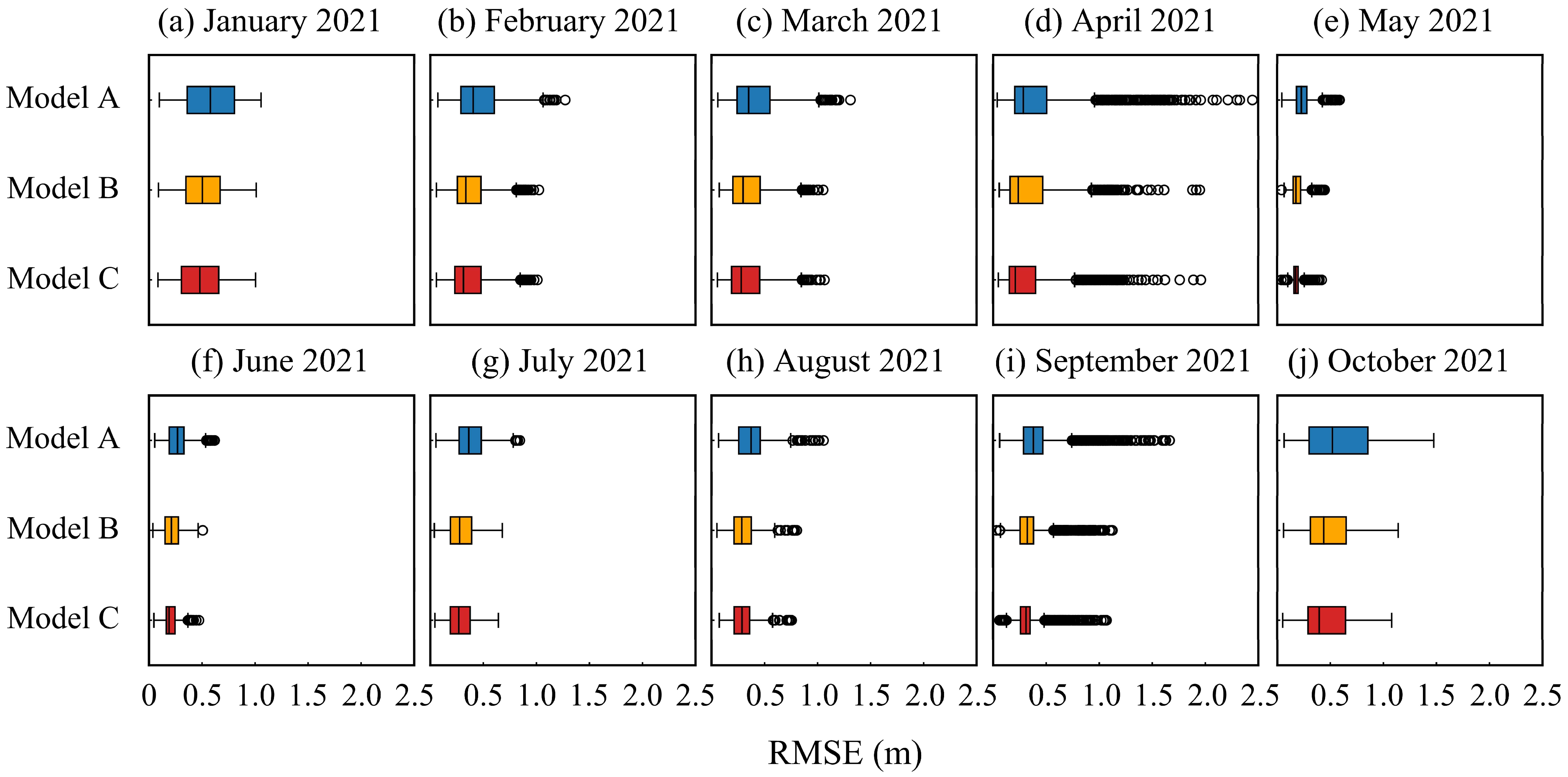
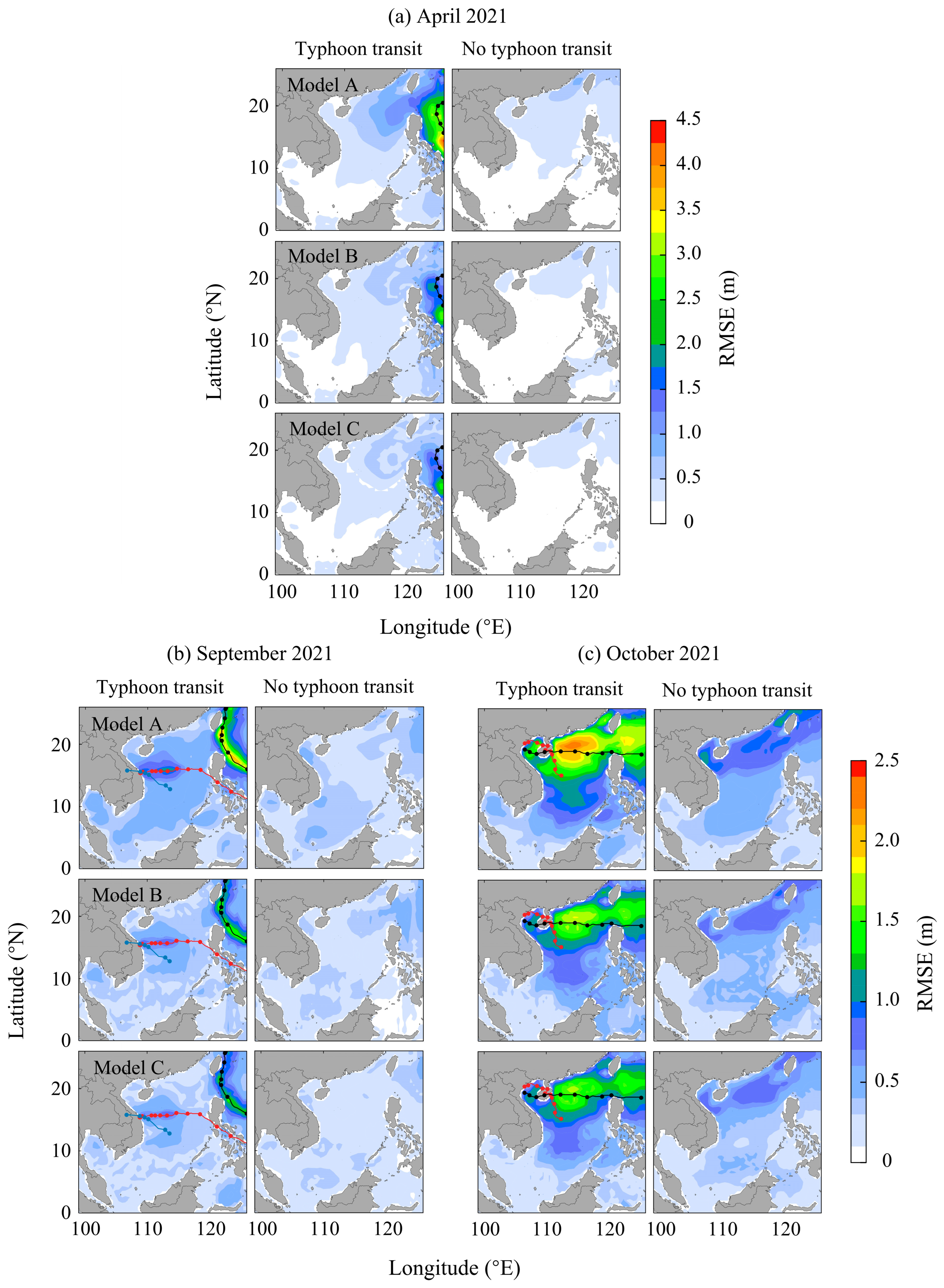
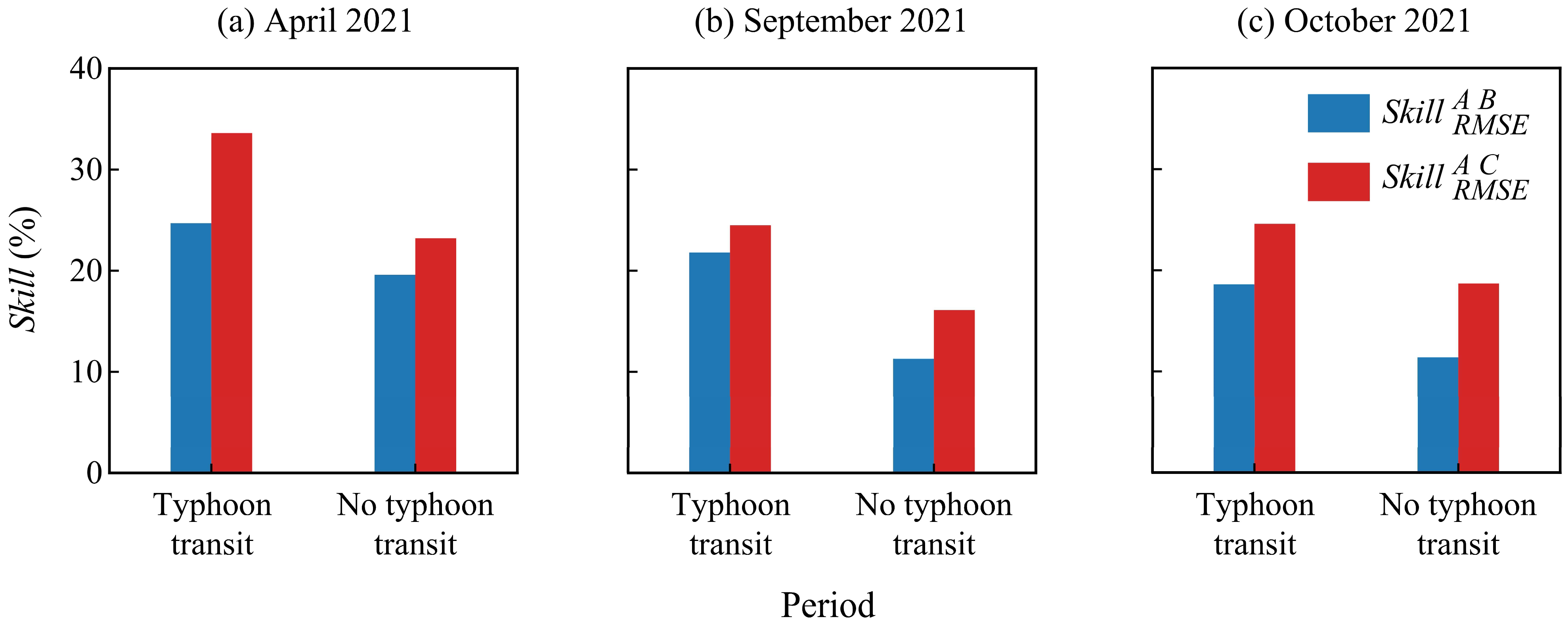
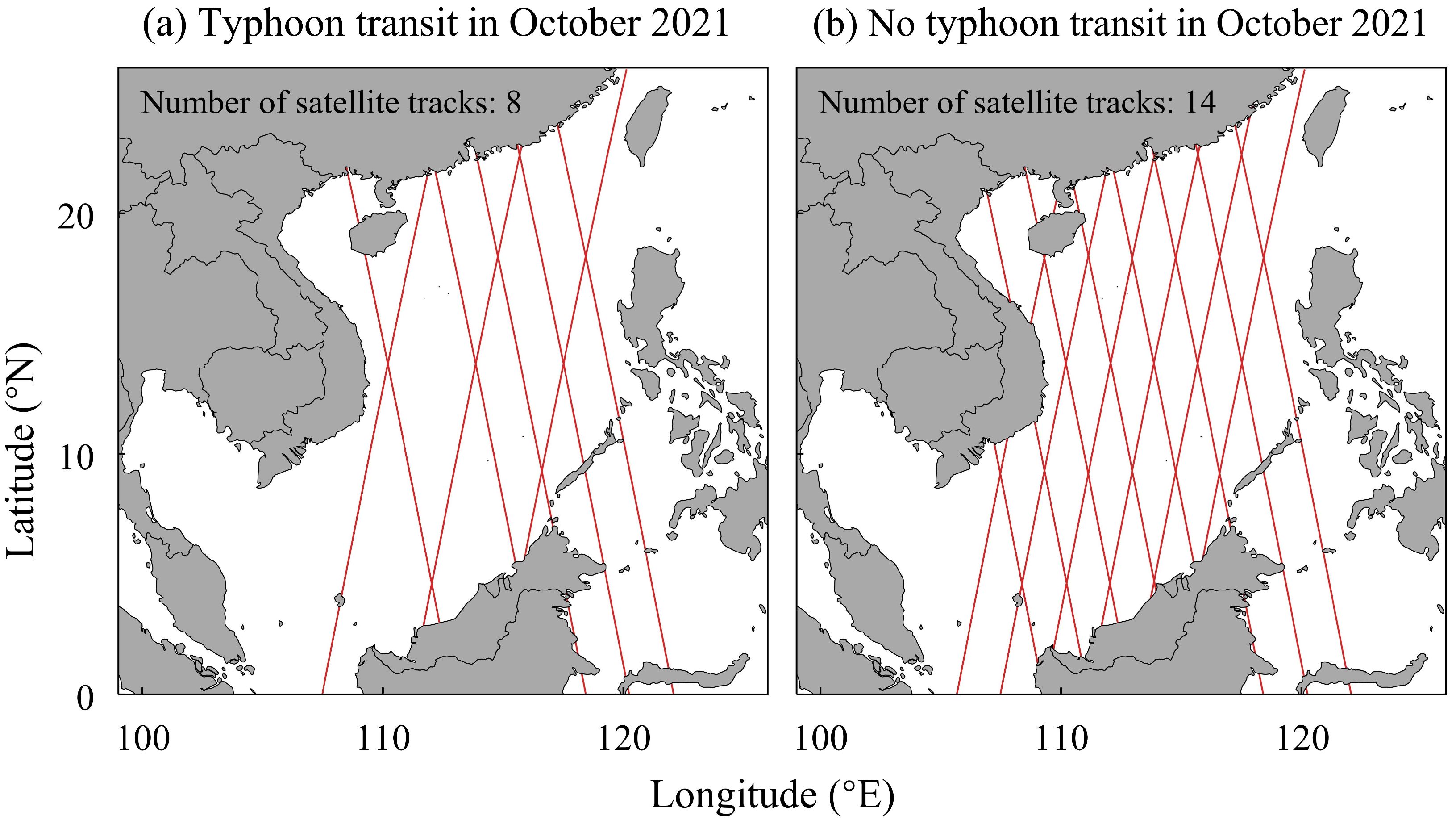

| Number | Name | Maximum Intensity | Maximum Wind Speed/m·s−1 | Start Date/YY-MM-DD HH | End Date/YY-MM-DD HH |
|---|---|---|---|---|---|
| 2102 | Surigae | Super typhoon | 68 | 2021-04-14 02 | 2021-04-24 17 |
| 2113 | Conson | Severe tropical storm | 30 | 2021-09-06 14 | 2021-09-12 17 |
| 2114 | Chanthu | Super typhoon | 68 | 2021-09-07 08 | 2021-09-18 05 |
| 2115 | Dianmu | Tropical storm | 18 | 2021-09-22 17 | 2021-09-24 08 |
| 2117 | Lionrock | Tropical Storm | 20 | 2021-10-06 08 | 2021-10-10 17 |
| 2118 | Kompasu | Typhoon | 35 | 2021-10-08 02 | 2021-10-14 17 |
| Forecast Time | Skill | 3-h | 6-h | 12-h | 24-h |
|---|---|---|---|---|---|
| RMSE | (%) | 15.7 | 15.9 | 16.7 | 17.6 |
| (%) | 19.4 | 18.8 | 19.9 | 19.0 | |
| CC | (%) | 0.82 | 1.80 | 2.72 | 2.90 |
| (%) | 1.02 | 2.54 | 3.63 | 2.65 | |
| MAPE | (%) | 3.40 | 7.19 | 8.46 | 12.2 |
| (%) | 3.84 | 10.5 | 13.2 | 14.8 |
| Periods | (%) | (%) |
|---|---|---|
| Typhoon transit | 21.7 | 27.5 |
| No typhoon transit | 14.1 | 19.3 |
Publisher’s Note: MDPI stays neutral with regard to jurisdictional claims in published maps and institutional affiliations. |
© 2022 by the authors. Licensee MDPI, Basel, Switzerland. This article is an open access article distributed under the terms and conditions of the Creative Commons Attribution (CC BY) license (https://creativecommons.org/licenses/by/4.0/).
Share and Cite
Han, L.; Ji, Q.; Jia, X.; Liu, Y.; Han, G.; Lin, X. Significant Wave Height Prediction in the South China Sea Based on the ConvLSTM Algorithm. J. Mar. Sci. Eng. 2022, 10, 1683. https://doi.org/10.3390/jmse10111683
Han L, Ji Q, Jia X, Liu Y, Han G, Lin X. Significant Wave Height Prediction in the South China Sea Based on the ConvLSTM Algorithm. Journal of Marine Science and Engineering. 2022; 10(11):1683. https://doi.org/10.3390/jmse10111683
Chicago/Turabian StyleHan, Lei, Qiyan Ji, Xiaoyan Jia, Yu Liu, Guoqing Han, and Xiayan Lin. 2022. "Significant Wave Height Prediction in the South China Sea Based on the ConvLSTM Algorithm" Journal of Marine Science and Engineering 10, no. 11: 1683. https://doi.org/10.3390/jmse10111683
APA StyleHan, L., Ji, Q., Jia, X., Liu, Y., Han, G., & Lin, X. (2022). Significant Wave Height Prediction in the South China Sea Based on the ConvLSTM Algorithm. Journal of Marine Science and Engineering, 10(11), 1683. https://doi.org/10.3390/jmse10111683






